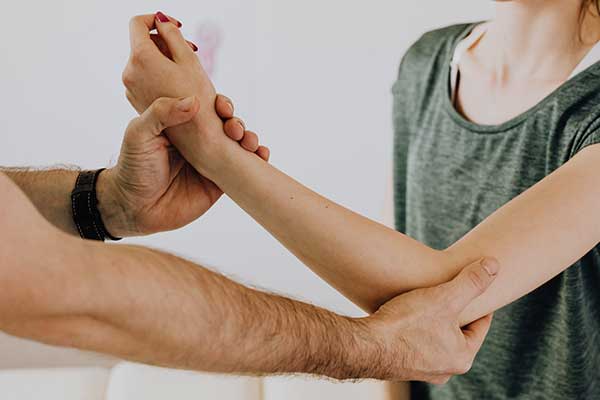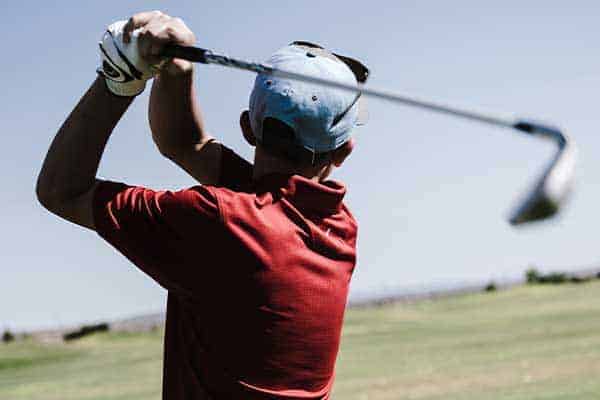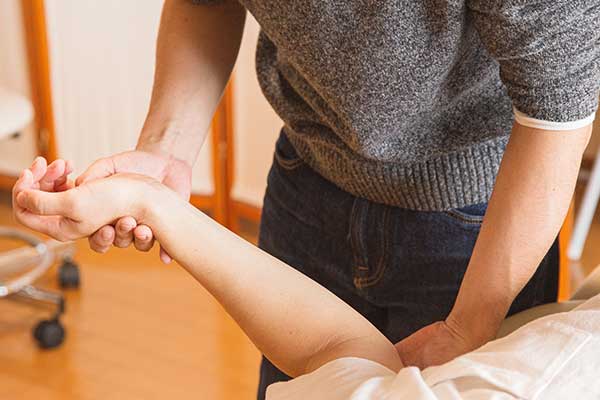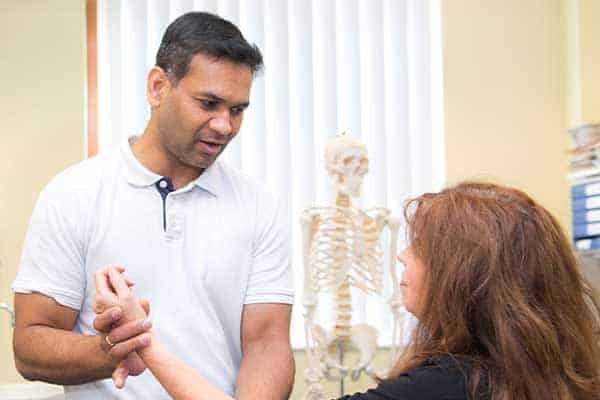Ligaments are strong bands of tissue that connect bones together and stop them from moving too far. The term sprain refers to an injury to your ligaments.
In your elbow, you have ligaments either side that stabilise the joint. When these ligaments are stretched or twisted too far, they become sprained. This term covers a range of damage from a few torn fibres to completely split in two.
What causes elbow ligament sprain?
Elbow ligament sprain often happens when you suffer a traumatic injury involving a sudden twisting of your arm or sideways force to your elbow. These types of injury are common in sport, and also when you fall onto an outstretched arm or sustain an impact while holding onto a rigid structure such as a steering wheel.
Elbow ligament sprains can also occur due to overuse, especially if you perform a repetitive activity that involves rapid movement of your arm such as an overhead swing or throw. This is again common in certain sports.
What are the symptoms of elbow ligament sprain?
Your symptoms will depend on the type and severity (or ‘grade’) of the elbow ligament sprain. If they result from a traumatic injury, they will develop quickly. Typically they will include:
- Pain in your elbow, which may also be referred down your forearm into your hand.
- Pain that worsens when you move your elbow, especially when you straighten it.
- Restricted movement in your elbow – you may be unable to straighten it.
- Bruising and/or swelling over the inner or outer side of your elbow joint.
- A feeling that your elbow is going to ‘give way’ when you push yourself out of a chair.
- A sensation of ‘clicking’ or ‘snapping’ when you try to move your elbow.
How is elbow ligament sprain diagnosed?
There are different grades of sprain.
- Grade 1: The ligament has been overstretched, causing soreness and some swelling, but no significant tearing.
- Grade 2: A partial tear of the ligament, causing pain, swelling and bruising. You may not be able to use your elbow fully.
- Grade 3: A full tear of the ligament. This will usually be very painful, swollen and bruised, and you will probably be unable to use your elbow at all.
If you have injured your elbow in an accident or fall, you should get checked out at your local A&E in order to ensure that you have not sustained a fracture instead of a sprain. Forced sideways motion of the elbow can also lead to the elbow joint becoming misaligned or even dislocated and this will require immediate diagnosis and treatment.
If your symptoms have developed gradually but you are experiencing significant pain or loss of movement in your elbow, you should also seek an assessment from a GP or another qualified health professional. There is no pressing need to seek an assessment for lesser symptoms, unless they do not improve with time and self-treatment.
What are the treatment options for elbow ligament sprain?
Depending on the severity of your injury, it may be advisable to start moving and strengthening your elbow again, as soon as possible, or to avoid using it. If you have been diagnosed with a severe sprain, your doctor or physiotherapist will be able to advise you on the best treatment and rehabilitation for you.
In all cases, try to manage the pain during the first few days and give your tissues time to recover. Identify the activities that make the pain worse and if possible stop them for a short period. If not, try to reduce them, modify the way you do them, or factor in more rest and recovery time between them.
You could try anti-inflammatory painkillers such as Ibuprofen. Some anti-inflammatory painkillers also come as creams or gels, which you can rub over your painful elbow. These tend to produce fewer side effects than those taken by mouth. If you cannot take anti-inflammatory painkillers, or if you have been advised not to take these during a particular phase of the healing process, other painkillers such as paracetamol, with or without codeine added, may be helpful. Ask your doctor or pharmacist for advice.
In certain cases, you may also benefit from taping the elbow area with athletic tape, or from the use of a special elbow brace or support. Your doctor or physiotherapist may recommend this, or you could ask your pharmacist for advice.
When resting, try to keep your elbow and forearm above the level of your heart. This can help to relieve pain. Try not to let your arm hang down by your side.
You could also put an ice pack on your inner or outer elbow area for 10-15 minutes, every three hours. (Do not put ice directly next to skin as it may cause ice burn. Wrap it in a damp tea towel. Remove the pack if irritation increases. Allow the area to return to normal temperature before reapplying the ice.)
Even while resting your arm, you should keep generally active. As soon as the pain has settled down, you should start exercises to restore strength and mobility in your elbow joint. Build up these exercises gradually and avoid any that cause lingering pain.
You may be recommended physiotherapy or other forms of manual therapy.
In rare cases, if your injury has been particularly severe, surgery may be recommended.
What is the prognosis (outlook) for elbow ligament sprain?
Recovering from an elbow ligament sprain may take weeks or months, depending on how severe it is and how effective your rehabilitation regime.
A completely torn ligament may take several months to heal and you may be unable to return to sport during this time.
How can I prevent recurrence of elbow ligament sprain?
If you have had an elbow ligament sprain, you may be likely to reinjure the same ligament. Strengthening the surrounding muscles and other tissues can help you avoid this.
Make sure your elbow is fully rehabilitated before resuming sports. If your injury was linked to a repetitive activity, think about changing your technique. If possible, try to factor in more time doing something else between bouts of repetitive activity.
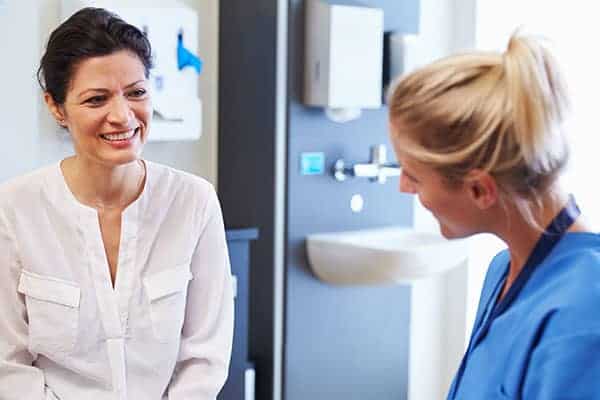
How to get referred
Find out how to get referred to Practice Plus Group MSK & Diagnostics for NHS treatment.

